Princeton Digital SAT 1 – Free Practice Test with Answers and Explanations
Are you preparing for the new Digital SAT and looking for a high-quality diagnostic tool? The Princeton Digital SAT 1 is the perfect starting point. This free practice test is designed to simulate the official exam experience, complete with answers and detailed explanations. It will help you determine your baseline score, identify your strengths, and focus on areas that need improvement.
Whether you’re aiming for a competitive college application or simply want to improve your score, this test will guide you toward a more effective study plan.
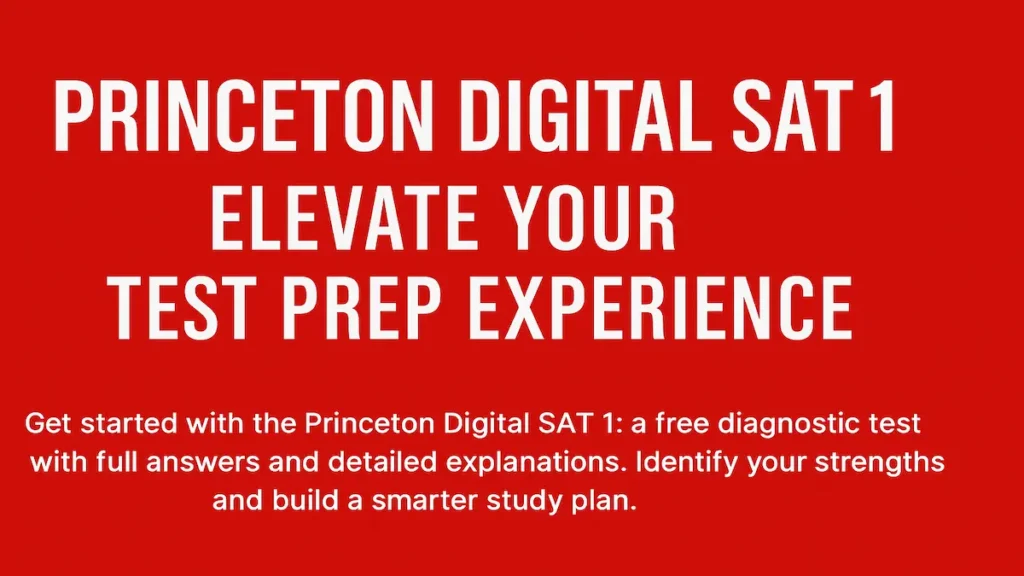
- What Is the Princeton Digital SAT 1 and How It Can Boost Your Score
- What’s Inside the Princeton Digital SAT 1 Free Practice Test
- How to Take the Princeton Digital SAT 1 – Step-by-Step
- Tips for Getting the Most Out of the Princeton Digital SAT 1
- Answer Key Digital SAT 1
- Why You Should Start with the Princeton Digital SAT 1
- Princeton Digital SAT 1 - Reading and writing explanations
What Is the Princeton Digital SAT 1 and How It Can Boost Your Score
The Princeton Digital SAT 1 is a full-length, realistic diagnostic test aligned with the official Digital SAT format. It helps you:
- Estimate your starting score according to the new SAT structure.
- Identify question types that require extra practice.
- Recognize content areas you’ve already mastered.
- Build a focused, personalized SAT study strategy.
Unlike the paper-based SAT, the Digital SAT uses two adaptive modules per section. Your performance in Module 1 determines the difficulty level of Module 2.
FOLLOW US ON FACEBOOK
What’s Inside the Princeton Digital SAT 1 Free Practice Test
This free Princeton Digital SAT 1 includes everything you need for an accurate practice experience:
- Module 1 for both Reading & Writing (RW) and Math.
- Two Module 2 options per section: Easier or Harder, based on your Module 1 performance.
- Complete answer keys and step-by-step explanations.
- Strategic advice to help you improve in future practice sessions.
How to Take the Princeton Digital SAT 1 – Step-by-Step
Follow these instructions to take the test under realistic conditions:
Reading and Writing
- Take Reading and Writing Module 1 (32 minutes).
- If you get fewer than 15 correct answers → Take RW Module 2 – Easier.
If you get 15 or more correct → Take RW Module 2 – Harder. - Start Module 2 immediately after Module 1 and allow yourself another 32 minutes.
- Take a 10-minute break before moving to the Math section.
Math - Take Math Module 1 (35 minutes).
- If you get fewer than 14 correct answers → Take Math Module 2 – Easier.
- If you get 14 or more correct → Take Math Module 2 – Harder.
Tips for Getting the Most Out of the Princeton Digital SAT 1
- Simulate test conditions: Work in a quiet environment without distractions.
- Use official timing: Stick to the time limits for each module.
- Review strategically: Only check the explanations after completing the full test.
- Track progress: Compare your results with future practice tests to see improvement.
Reading and Writing - Module 1
39 minutes 33 questionsDirections: The questions in this section address a number of important reading and writing skills. Each question includes one or more passages, which may include a table or graph. Read each passage and question carefully, and then choose the best answer to the question based on the passage(s).
All questions in the section are multiple-choice with four answer choices. Each question has a single best answer
Which choice completes the text with the most logical and precise word or phrase?
Reading and Writing - Module 2 - Easier
Directions: The questions in this section address a number of important reading and writing skills. Each question includes one or more passages, which may include a table or graph. Read each passage and question carefully, and then choose the best answer to the question based on the passage(s).
All questions in this section are multiple-choice with four answer choices. Each question has a single best answer.
Which choice completes the text with the most logical and precise word or phrase?
Reading and Writing - Module 2 - Harder
Directions: The questions in this section address a number of important reading and writing skills. Each question includes one or more passages, which may include a table or graph. Read each passage and question carefully, and then choose the best answer to the question based on the passage(s).
All questions in this section are multiple-choice with four answer choices. Each question has a single best answer.
Which choice completes the text with the most logical and precise word or phrase?
Which choice completes the text with the most logical and precise word or phrase?
Which choice completes the text with the most logical and precise word or phrase?
Which choice completes the text with the most logical and precise word or phrase?
Which choice completes the text with the most logical and precise word or phrase?
Which choice completes the text with the most logical and precise word or phrase?
Which choice completes the text with the most logical and precise word or phrase?
Which choice completes the text with the most logical and precise word or phrase?
business charge to acquit myself of. In your reception
of it, don’t heed me any more than if I was a speaking
machine—truly, I am not much else. I will, with your
leave, relate to you, miss, the story of one of our
customers.”
“Story!”
He seemed wilfully to mistake the word she
had repeated, when he added, in a hurry, “Yes,
customers; in the banking business we usually call
our connection our customers. He was a French
gentleman; a scientific gentleman; a man of great
acquirements—a Doctor.”
Based on the text, how does Mr. Lorry interact with Miss Manette?
Which finding, if true, would most directly support Abel’s claim?
Which of the following best illustrates the researcher’s claim?
Which finding, if true, would most directly support the neurologists’ hypothesis?
Which finding, if true, would most directly support Garber’s argument?
Which choice most logically completes the text?
Which choice most logically completes the text?
Which choice most logically completes the text?
Which choice completes the text so that it conforms to the conventions of Standard English?
Which choice completes the text so that it conforms to the conventions of Standard English?
Which choice completes the text so that it conforms to the conventions of Standard English?
Which choice completes the text so that it conforms to the conventions of Standard English?
Which choice completes the text so that it conforms to the conventions of Standard English?
Which choice completes the text so that it conforms to the conventions of Standard English?
Which choice completes the text with the most logical transition?
Which choice completes the text with the most logical transition?
Which choice completes the text with the most logical transition?
- To restore oyster reefs in Australia, limestone boulders are submerged to provide habitats, but baby oysters need help finding the boulders.
- A team from University of Adelaide looked into using sound as a way to encourage the baby oysters to attach to the boulders
- The research team recorded sounds at the healthy Port Noarlunga Reef to play near the submerged boulders
- Boulders in the area with the soundscape attracted around 17,000 more oysters per square meter compared to boulders without the soundscape.
- Soundscapes can indicate a healthy place for baby oysters to grow and can be a cost-effective way to restore oyster reefs.
- Neanderthals are an extinct species of humans who died out about 40,000 years ago and are the closest evolutionary relatives of present-day humans.
- Studying the genomes of Neanderthals provides insight into human evolution.
- Professor Svante Pääbo is a Swedish geneticist and the director of the Department of Genetics at the Max Planck Institute for Evolutionary Anthropology.
- His landmark study presented the first draft sequence of the Neanderthal genome.
- Laurits Skov of the Max Planck Institute for Evolutionary Anthropology has a doctorate in bioinformatics and studied evolutionary anthropology.
- One of his recent studies revealed the genomes of a family of Neanderthals.
Math Test - Module 1
DIRECTIONS: The questions in this section address a number of important math skills. Use of a calculator is permitted for all questions.
NOTES: Unless otherwise indicated:
- All variables and expressions represent real numbers.
- Figures provided are drawn to scale.
- All figures lie in a plane.
- The domain of a given function f is the set of all real numbers x for which f(x)is a real number.
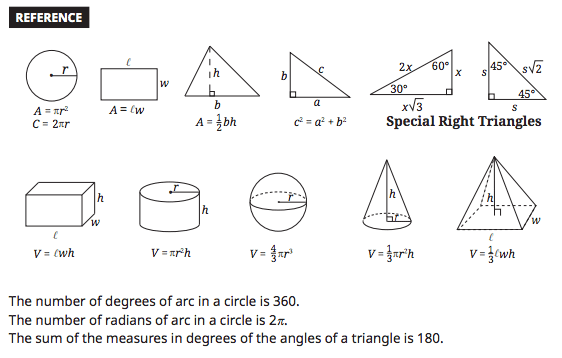
The number of degrees of arc in a circle is 360. The number of radians of arc in a circle is 2π. The sum of the measures in degrees of the angles of a triangle is 180.
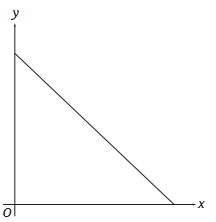
Question 5: The total amount of plastic remaining to be recycled in a facility over x shifts is represented by the graph above. Which of the following represents the y-intercept of the graph?

What is the probability that a textbook chosen at random will be a new textbook? (Express your answer as a decimal or fraction, not as a percent.)
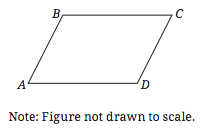
Question 11: In parallelogram ABCD shown above, the length of \(\overline{AB}\) is one-third the length of \(\overline{AD}\). The perimeter of the parallelogram is 64. What is the length of \(\overline{AB}\)?
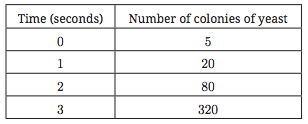
Question 13: The table above shows the exponential growth of a type of yeast over time s, in seconds. There are c total yeast colonies on the count plate. What is the equation that represents this relationship, assuming that no yeast was added or removed after counting began?
19x + 10y = 14
Question 18: When graphed in the xy-plane, the linear equations shown above intersect at (a, b). What is the value of a?
Question 21: The linear function f(x), given above, is perpendicular to g(x) when graphed in the xy-plane. If g(0) = 0, what is the value of g(2)?
\(\frac{y}{10} = -x\)
Question 22: The system of equations above has exactly one solution. If k is a constant, what is the value of k?
Math Module 2 - Easier:
DIRECTIONS: The questions in this section address a number of important math skills. Use of a calculator is permitted for all questions.
NOTES: Unless otherwise indicated:
- All variables and expressions represent real numbers.
- Figures provided are drawn to scale.
- All figures lie in a plane.
- The domain of a given function f is the set of all real numbers x for which f(x)is a real number.

The number of degrees of arc in a circle is 360. The number of radians of arc in a circle is 2π. The sum of the measures in degrees of the angles of a triangle is 180.
Question 4: Which of the following expressions is equivalent to the one above?
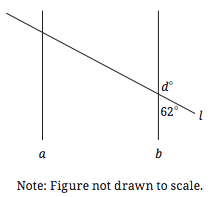
Question 13: In the figure above, what is the value of d if line a is parallel to line b?
Question 14: In the xy-plane, the graph of a line with an x-intercept of (c, 0) and a y-intercept of (0, k), where c and k are constants, can be represented by the equation above. What is the value of c/k?

Question 17: When the linear function y = f (x) is graphed in the xy-plane, the graph contains the corresponding values of x and f (x) shown in the table above. Which of the following could represent the function?
Math Module 2 - Harder:
DIRECTIONS: The questions in this section address a number of important math skills. Use of a calculator is permitted for all questions.
NOTES: Unless otherwise indicated:
- All variables and expressions represent real numbers.
- Figures provided are drawn to scale.
- All figures lie in a plane.
- The domain of a given function f is the set of all real numbers x for which f(x)is a real number.

The number of degrees of arc in a circle is 360. The number of radians of arc in a circle is 2π. The sum of the measures in degrees of the angles of a triangle is 180.
Question 4: In the equation above, what is the value of a – 3?
y = –3x + 10
Question 11: The point (a, b) is an intersection of the system of equations above when graphed in the xy-plane. What is a possible value of a?
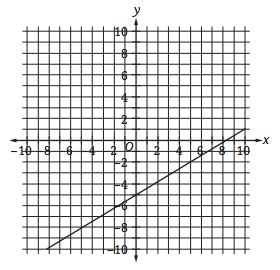
Question 14: Which equation defines function g, if the graph of y = g(x) – 10 is shown above?
Question 16: In the xy-plane, the graph of a line with an x-intercept of (c, 0) and a y-intercept of (0, k), where c and k are constants, can be represented by the equation above. What is the value of c/k?
21g + 21 = 6f – 15g
Question 17: If c is a constant, and the system of equations shown above has infinitely many solutions, what is the value of c?

Question 19: Four values of x and their corresponding values of g(x) are shown in the table above for the linear function g. The equation g(x) = cx + d defines function g, and c and d are constants. What is the value of c + d?
Question 20: A data set consists of 5 positive integers greater than 101. What is the value of the smallest integer in the data set if the mean of the entire data set is an integer that is less than the mean of the four integers from the data set shown above?
I. Angle B measures 40°
II. Angle Y measures 50°
III. Angle Z measures 63°
Answer Key Digital SAT 1
Reading and Writing
| Module 1 | Correct | Module 2: Easier | Correct | Module 3: Harder | Correct |
|---|---|---|---|---|---|
| 1 | D | 1 | D | 1 | C |
| 2 | B | 2 | A | 2 | B |
| 3 | B | 3 | C | 3 | C |
| 4 | A | 4 | A | 4 | D |
| 5 | D | 5 | B | 5 | A |
| 6 | A | 6 | B | 6 | C |
| 7 | A | 7 | A | 7 | A |
| 8 | A | 8 | A | 8 | D |
| 9 | A | 9 | C | 9 | A |
| 10 | B | 10 | D | 10 | B |
| 11 | A | 11 | D | 11 | B |
| 12 | B | 12 | C | 12 | A |
| 13 | D | 13 | C | 13 | A |
| 14 | A | 14 | C | 14 | B |
| 15 | C | 15 | A | 15 | C |
| 16 | C | 16 | A | 16 | A |
| 17 | D | 17 | D | 17 | C |
| 18 | A | 18 | B | 18 | B |
| 19 | A | 19 | D | 19 | A |
| 20 | B | 20 | D | 20 | A |
| 21 | B | 21 | A | 21 | D |
| 22 | C | 22 | D | 22 | D |
| 23 | D | 23 | C | 23 | A |
| 24 | D | 24 | D | 24 | C |
| 25 | C | 25 | C | 25 | D |
| 26 | D | 26 | A | 26 | D |
| 27 | C | 27 | A | 27 | B |
MATH
| Module 1 | Correct | Module 2: Easier | Correct | Module 3: Harder | Correct |
|---|---|---|---|---|---|
| 1 | B | 1 | C | 1 | A |
| 2 | C | 2 | D | 2 | A |
| 3 | C | 3 | B | 3 | D |
| 4 | B | 4 | C | 4 | B |
| 5 | D | 5 | A | 5 | C |
| 6 | A | 6 | B | 6 | D |
| 7 | D | 7 | C | 7 | B |
| 8 | B | 8 | A | 8 | B |
| 9 | A | 9 | B | 9 | C |
| 10 | B | 10 | D | 10 | C |
| 11 | A | 11 | D | 11 | A |
| 12 | A | 12 | B | 12 | A |
| 13 | D | 13 | A | 13 | D |
| 14 | A | 14 | A | 14 | C |
| 15 | C | 15 | D | 15 | D |
| 16 | D | 16 | B | 16 | A |
| 17 | C | 17 | B | 17 | B |
| 18 | C | 18 | C | 18 | C |
| 19 | D | 19 | D | 19 | B |
| 20 | D | 20 | A | 20 | A |
| 21 | C | 21 | D | 21 | B |
| 22 | B | 22 | A | 22 | D |
Need more practice tests? Enter here!
Why You Should Start with the Princeton Digital SAT 1
Taking this test first gives you a clear starting point for your SAT preparation. It reveals your current level, highlights the topics to prioritize, and helps you develop a focused study plan. Plus, it mirrors the real Digital SAT experience, so you’ll feel more confident on test day.

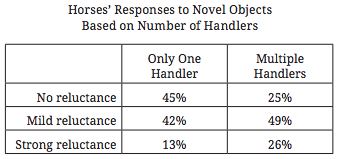


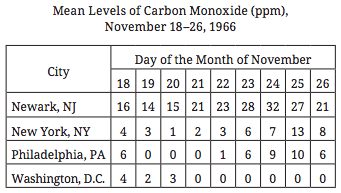
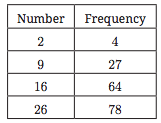
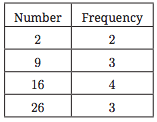
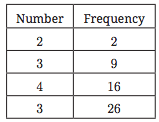
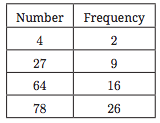




Leave a Reply